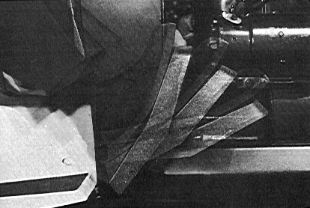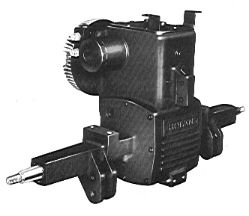| |
|
1969 Brochure
Page 4
|
Hydrostatic transmission
with Foot-Pedal control
|
|

|

|
|
The Hydrostatic (automatic)
transmission, available on the Husky 775, 1225, 1250 and 1455, gives
Bolens tractors a greatly increased efficiency and versatility.
These hydrostatic transmissions are manufactured by the Eaton Marshall
Division of Eaton Yale and Towne, a national leader in fluid systems
far the automotive industry. |
 |
Hydraulic Lift
Bolens takes the back-breaking
strain out of raising and lowering attachments on the Husky 1225,
1250 and 1455, Those three units are equipped with a hydraulic
lift system that is dashboard mounted
|
|
Performance
advantages include:
(1) Smooth speed change from full forward through zero
to full reverse with a single control, without use o£ hands.
(2)
Complete matching of power to load.
(3)
Positive control and instant braking.
|
and controlled by
a lever within easy reach of the operator. In addition, a position
gauge indicates the original height of the attachment, and the
operator can relocate any implement precisely.
Controlled
Differential
|
| |
Forward and reverse
are bath controlled by the right foot pedal. This is a distinct
engineering advantage of Bolens units with hydrostatic transmission.
Clutch and gear levers are completely eliminated and replaced
by variable forward and reverse control pedal, This convenient
foot control allows both hands freedom to steer and operate attachments. |
Available on the Husky
850, 1050, 1220 and 1225, Bolens exclusive controlled differential
allows the tractor operator to match traction require meats
to ground conditions.
A screw knob located
on the left rear wheel tightens a brass conical shaped collar
(which is keyed to an axle driving the right hand wheel) into
a mating content shape in the left hand wheel.
|
|
Another important feature
of this hydrostatic drive is the reversing characteristic of braking.
When braking. the motor becomes a pump in a closed hydraulic circuit.
The roles o€ the pump and motor are reversed so that the pump,
engine and control system brake the wheels. When the pump is at
zero angle, no flow can take place and the drive is lacked hydraulically. |
| This increases
friction between these two ports to a almost locked state.
Thus, differential action between the wheels is gradually
reduced (by turning the knob clockwise) until the action
is practically eliminated and both rear wheels have driving
power. |
 |
|
|
|
|